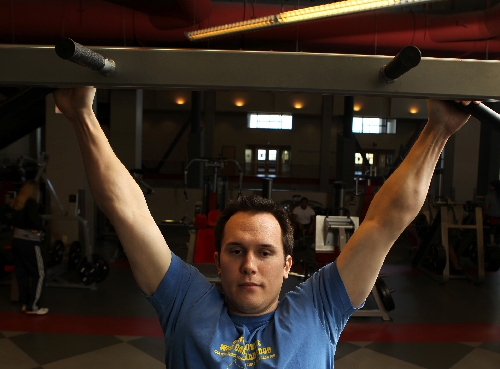Think you’ve got pull? Try this variable, potent exercise

Revisiting basic exercises with a critical eye can help identify faults in your form. Last week we looked at the push-up. Today, we discuss the pull-up, one of those exercise that should be remastered to keep it effective.
Pull-ups and chin-ups work a majority of the muscles in the back. The major muscles that contribute to pull-ups are the latissimus dorsi, lower trapezius, rhomboids, teres major (back of the armpit), biceps and brachialis (next to the biceps). Pull-ups will work more lats, while reverse grip chin-ups will require more effort by the biceps.
There are many kinds of pull-ups. Different people will give you a variety of tips on such things as grip positions, width you hold your hands apart, and how far to pull up. There are even pull-ups that use a plyometric motion called kipping to help the body up. The pull-ups discussed today are the very basic and the foundation of all the others. If you don’t quite have the upper body strength to do pull-ups, then use the form and principles here on the assisted pull-up machine. Progress by using the right form learned here and you’ll stay injury-free. (See my column on training for teens at www.lvrj.com/columnists/Chris_Huth.html.)
When doing a pull-up, if you’re hanging from a bar with your shoulders touching your ears, then your form needs some work. Try contracting the upper back by bringing the shoulder blades closer together. You can get the feel for this without even putting down the newspaper. Notice that when the shoulder blades come closer together, the shoulders themselves are moved down and back. This position will keep your shoulders from getting hurt. Doing pull-ups with loose shoulders will put too much strain on the rotator cuff. If the upper back is contracted, then the arms won’t be able to fully straighten, causing a slight bend in the elbows. This is one exercise where a big range of motion does not mean a better form.
Having the upper back contracted will also lock the spine in a straight position. The last thing you want to do is a back exercise with a wobbly spine. You’ll be on the pain train to Injury City. The neck is also part of the spine. Many people raise their chin at the top end of a "chin-up" to try to get the chin physically over the bar. This action will lead to neck injuries. Keep the neck straight by looking forward and not up. It’s best to do half of a correct repetition then a whole wrong one that could cause injury.
Incorrect elbow position is a less common issue but also worth mentioning. If the lats are not strong enough to do a pull-up, then the biceps take over. If the biceps take over, the elbows will point forward. If the shoulder is in the wrong position, the elbows will try to point backward. At the top of the pull-up, the elbows will be next to the rib cage. Reverse-grip pull-ups require the elbows to be pointed out because they use the biceps more than wide-grip pull-ups.
If your pull-ups are controlled, you won’t swing on your way up or down. Some types of pull-ups use a swing or a kipping motion. Make sure you can do the regular ones before choosing to progress to a plyometric version.
Chris Huth is a Las Vegas trainer. You can contact him at 702trainer@gmail.com. Before beginning any exercise program, consult your physician.